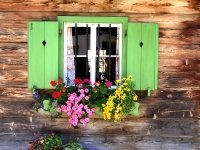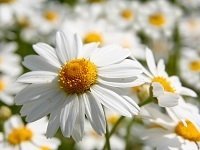Grow Herbs for the Kitchen
Herbs make life sweeter, healthier, and taste better. They have been cultivated for centuries and, by definition, include any plant used as a medicine or seasoning. The culinary term "herb" usually refers to the leafy part of the plant but may include seed pods, roots, and bark. Which herbs to grow depends on your personal preference. Here are some that are tops for the culinary uses.
Basil
Ocimum basilicum is native to Mediterranean climates. It prefers full sun, regular watering, well-drained, rich soil, and fertilizer only once during the growing season. Sow seeds in early spring and make successive sowings every two weeks of these short-lived annual plants. Keep the flower spikes pinched back to promote bushiness unless you want to attract beneficial insects to your garden. In that case, leave some of the flower stalks, but remember that you'll sacrifice leaf production.
Chives
Allium schoenoprasum is a perennial that requires full sun and fertile soil. Regular watering is recommended to promote strong healthy foliage. Chives can be grown from seed or plants. To harvest, cut a clump of leaves from the base of the plant with scissors. Use chives on baked potatoes, in egg and cheese dishes, and to make a tasty herb butter. The purple blossoms are beautiful as a garnish.
Oregano
Origanum is a perennial plant that requires full sun and moderate to little water. It's related to mint and is used in Italian cuisine. The leaves can be used fresh or dried. Its low-growing nature makes it an excellent choice for a rock garden or a ground cover.
Parsley
Petroselinum crispum is a biennial herb that's usually grown as an annual. It requires afternoon shade in hot summer regions and regular water. The seeds should be soaked prior to planting to speed germination and, even after soaking, may take as long as 2 to 3 weeks to sprout.
Rosemary
Rosmarinus officinalis is a Mediterranean native that requires bright light, minimum water, and well-drained soil. It's a tender perennial shrub that needs protection from frost. It has very tender roots, and care should be taken not to disturb them at transplanting time. Rosemary is used in meat dishes, stews, and vegetables.
Sage
Salvia officinalis is a perennial plant that requires full sun, well-drained soil, and regular watering. It's a traditional poultry seasoning and its leaves are delicious baked in a slow oven for forty five minutes with onions, brown sugar, and balsamic vinegar. Sage is an ancient healing herb used to cure broken bones, wounds, stomach disorders, and loss of memory.
Tarragon
Artemisia dracunculus is a perennial member of the daisy family that requires full sun, well- drained soil, and moderate water. It's a little fussy to grow, so I suggest purchasing three plants and planting them in different locations to ensure success. Tarragon dies to the ground in winter. It's a classic herb to accompany fish. True tarragon cannot be propagated from seed, so start with plants grown from cuttings. Avoid flavorless seed-propagated Russian tarragon.
Growing Herbs
All you need is a small, sunny spot to grow herbs in your own garden. A plot 2 feet by 2 feet is adequate to grow enough plants for seasoning your food and still have plenty left over for gifts. You can even grow herbs in a window box or in containers. Strawberry jars (usually ceramic or clay pots with holes all around the outside for the plants to grow through) make wonderful containers for an herb collection.
Read more from The National Gardening Association.








